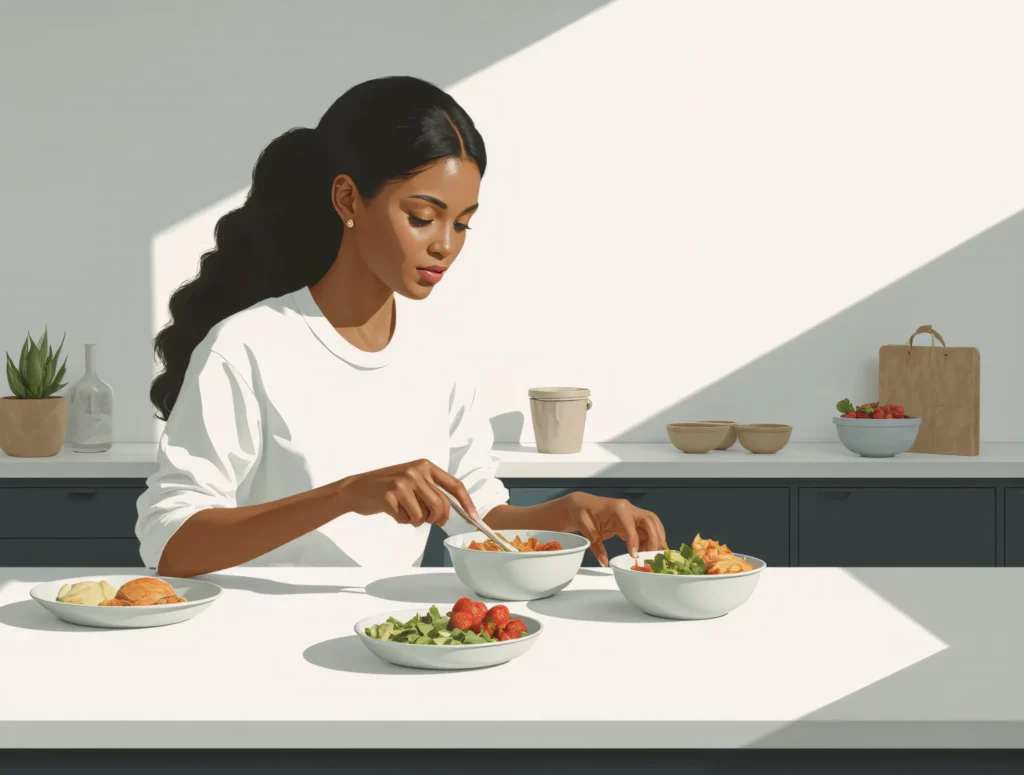Time feels like the real ingredient most of us are missing. A grocery trip on Sunday, a few quick meals by Tuesday, and then chaos sets in. The fridge becomes a museum of half used produce and good intentions.
That is not failure. It is decision fatigue disguised as hunger. When every meal requires fresh thought, your brain burns energy meant for better things. Structure, not willpower, is what keeps most people consistent.
The fix is not another strict diet or endless meal prep marathon. It is a simple system that turns weekday stress into calm rhythm.
Reframing the Week: Structure Over Restriction
Think of batch cooking as a rhythm that works for you. The goal is not to lock your meals but to free your schedule. You prep once and eat flexibly while your plan stays steady. FitChef calls this structure over restriction enough order to stay consistent, enough freedom to stay human.
When you build your week this way, you trade the stress of spontaneity for the peace of predictability. You are not losing freedom; you are choosing smarter defaults so life feels lighter.
The Three Step System: How to Prep Once and Eat Well All Week
Step 1: Blueprint the Base
Before chopping an onion, define two lunches and two dinners that reheat beautifully such as chili, sheet pan chicken, lentil curry, or pasta bake. Double the portions; those anchors become midweek safety nets. Add easy items like eggs, wraps, and prewashed greens for fast breakfasts or snacks.
Most people fail here because they start with recipes instead of rhythm. Planning rhythm first means every dish earns its place.
Step 2: Cross Utilize Ingredients
Choose two or three proteins, three or four versatile vegetables, and grains that overlap between meals. Roasted chicken works for wraps, stir fry, or bowls while vegetables reappear in omelets or pasta. It is not leftovers; it is ingredient efficiency. This is how professionals and platforms like FitChef reduce cost and grocery stress through ingredient optimization.
Many readers think variety demands effort. In reality, it is smart reuse that creates variety because your base stays familiar while flavors shift.
Step 3: Schedule the Session
Pick one prep block each week for about sixty to ninety minutes and treat it as a meeting with your future self. Cook grains, roast proteins, chop vegetables, and preportion a few ready to grab snacks. Store by meal type rather than ingredient. Future you will thank past you when every container already represents a full meal.
Structure is self care in disguise. You are not just feeding yourself; you are freeing tomorrow’s brainpower.
Tools That Make It Easier
The biggest barrier is not motivation but maintenance. That is where technology and templates make rhythm effortless. Modern meal planning apps like FitChef automate calorie targets, portioning, and grocery lists so your weekly system stays accurate without spreadsheets. As your goals shift between weight loss, maintenance, or training, the plan evolves automatically.
If you prefer manual planning, create a simple checklist with anchor recipes, a reusable ingredient list, a prep calendar slot, and a leftover plan. Consistency comes from friction free tools. The less time you spend redeciding, the more time you spend living.
Rethink Variety: The Core Plus Accent Method
Variety is not about how many new recipes you try. It is about small twists on your base meals.
Core
Your prepped batch of protein, grain, and vegetables.
Accent
One or two new flavors per meal such as sauces, herbs, or toppings. For example roasted salmon with quinoa and spinach becomes three different meals depending on accent: teriyaki drizzle, lemon dill yogurt, or chili lime dressing.
This mindset rewires perfectionism. You are not chasing novelty; you are curating comfort with micro changes.
Time Budget Framework: Ninety Minutes to Calm
| Minute | Task | Focus |
|---|---|---|
| 0 to 15 | Prep proteins and start oven | Front load energy tasks |
| 15 to 40 | Chop and precook grains | Stack tasks heat and hands |
| 40 to 70 | Assemble anchor dishes | Use sheet pans for hands off cooking |
| 70 to 90 | Cool, store, label | Closure equals visible order |
Seeing containers lined up in your fridge delivers instant relief a visible sign that the week ahead will not unravel. You cannot control every meeting or mood swing, but you can control whether dinner is already halfway done.
When Life Interrupts the Plan
Life will interrupt. A child gets sick, a meeting runs late, or the weather changes your appetite. Use this rescue loop: swap a meal by reusing your anchor dish differently, freeze one portion to build a backup, or replace the next prep session with a grocery list refresh instead of full cooking. Structure flexes; it does not break. The best systems adapt as life evolves, not punish you when it does not go to plan.
The Takeaway: Freedom Through Systems
Batch cooking is not about obsession; it is about peace of mind on autopilot. Once the base structure is in place you start noticing smaller wins calmer mornings, less food waste, better energy, and that rare feeling of being ahead of the day. You are not supposed to love cooking every night. You are supposed to love having already done it.




